Please see the below PDF for Owen’s reflections on this project as a whole.
Author: s2128018
Final Documentation – Video
Below is a video put together by Owen that documents the performance day. It incorporates footage from 5 different cameras, a live audio feed from both my and Mengru’s laptops, and a stereo recording of the sound of the room during the performance! Edited in Davinci Resolve.
25.03.23 rehearsal
Prep for Rehearsal
-I (Owen) am thinking about ways in which an Ableton Session View can be ‘performed’ live.
-Using MIDI controllers that have rotary dials and faders, it is possible to adjust ANY parameter inside Ableton. But which ones??? That is the important question.
-What I am going to try tomorrow during our rehearsal is using the Evolution U-Control. I will basically have 8 faders, each of which controls the level of a track in Ableton – so I can mix different ‘instruments’ together in order to progress the soundtrack. I can also select different ‘scenes’ in Session View (i.e. rows of MIDI clips) using the << and >> buttons. Then, I have plenty of dials (24 in total) left to manipulate various effects (effects TBD, but probably some kind of distortion for starters).
-Pictured below: Evolution U-Control (silver one in my lap); Faderfox FT3 and Korg nanoKontrol2 (black and silver ones on desk); Ableton Live Session View (on my laptop)
–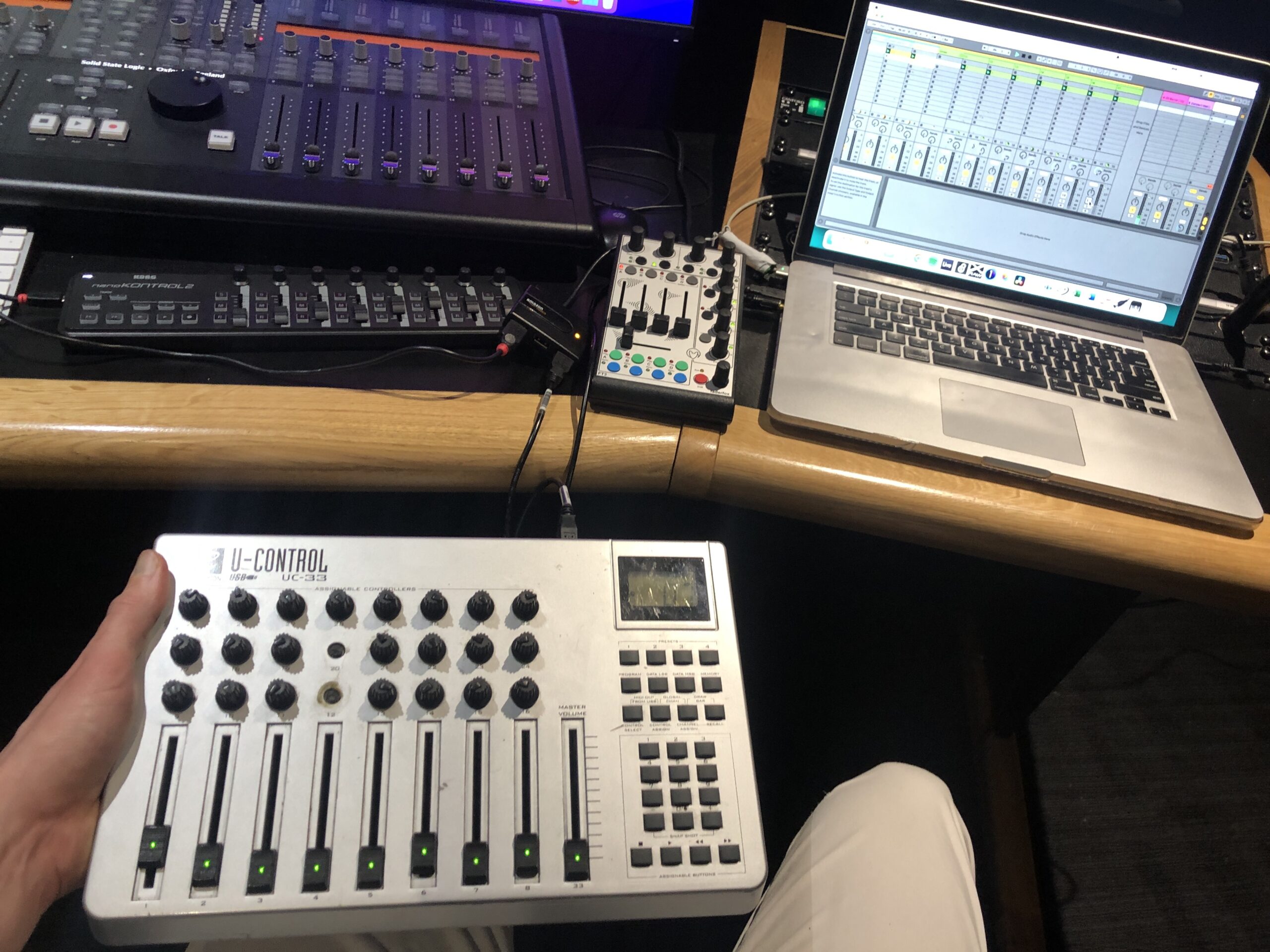
Rehearsal
We got together in the Atrium to begin practicing the actual performance. Vibha, Shruti and Yi worked on the visuals, while Maggie and Owen worked on the sound. The main takeaway is that we need to continue practicing, because you don’t really find out what doesn’t work until you fully rehearse. See pics from the rehearsal below.
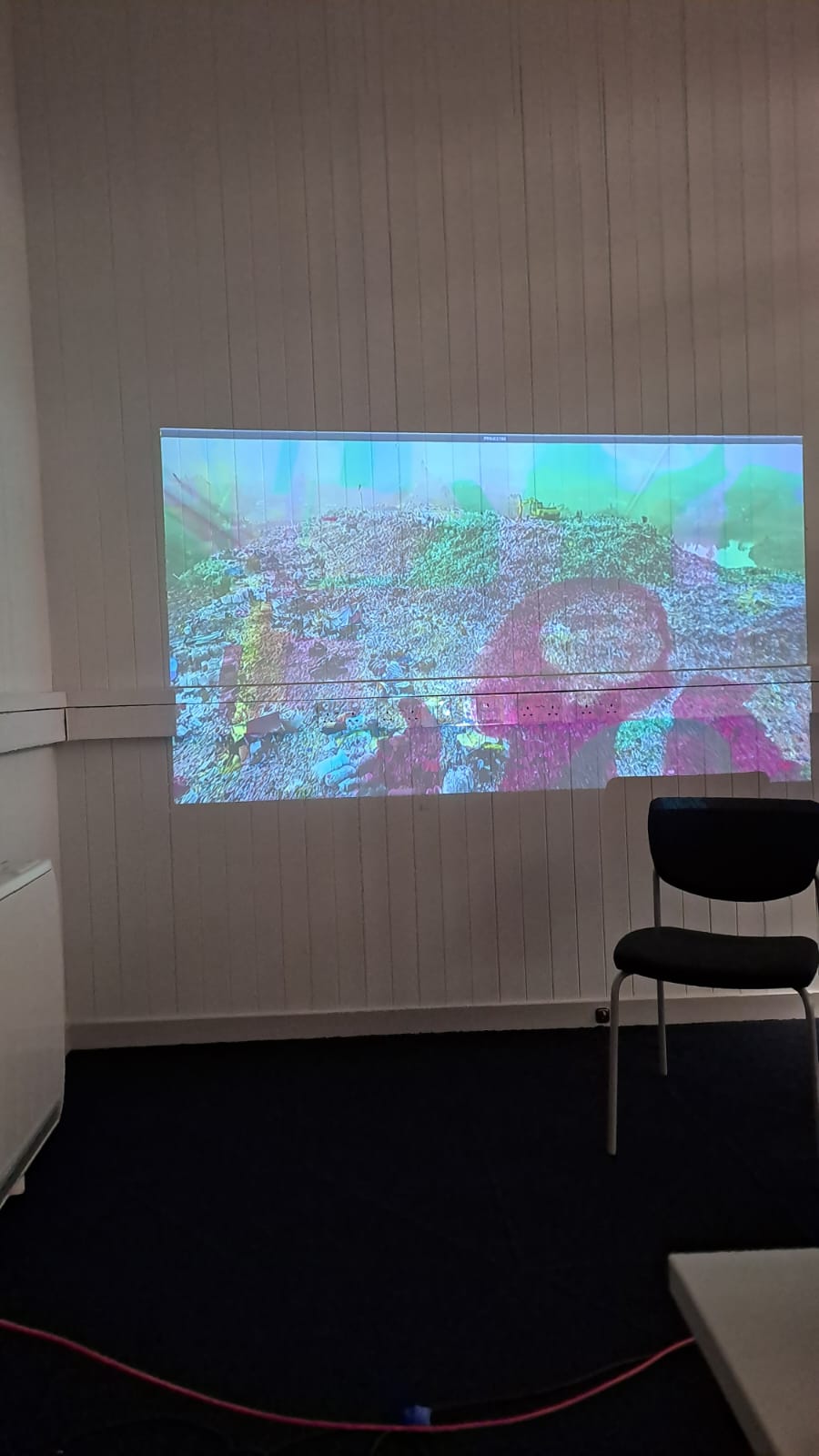
Practicing projections on wall
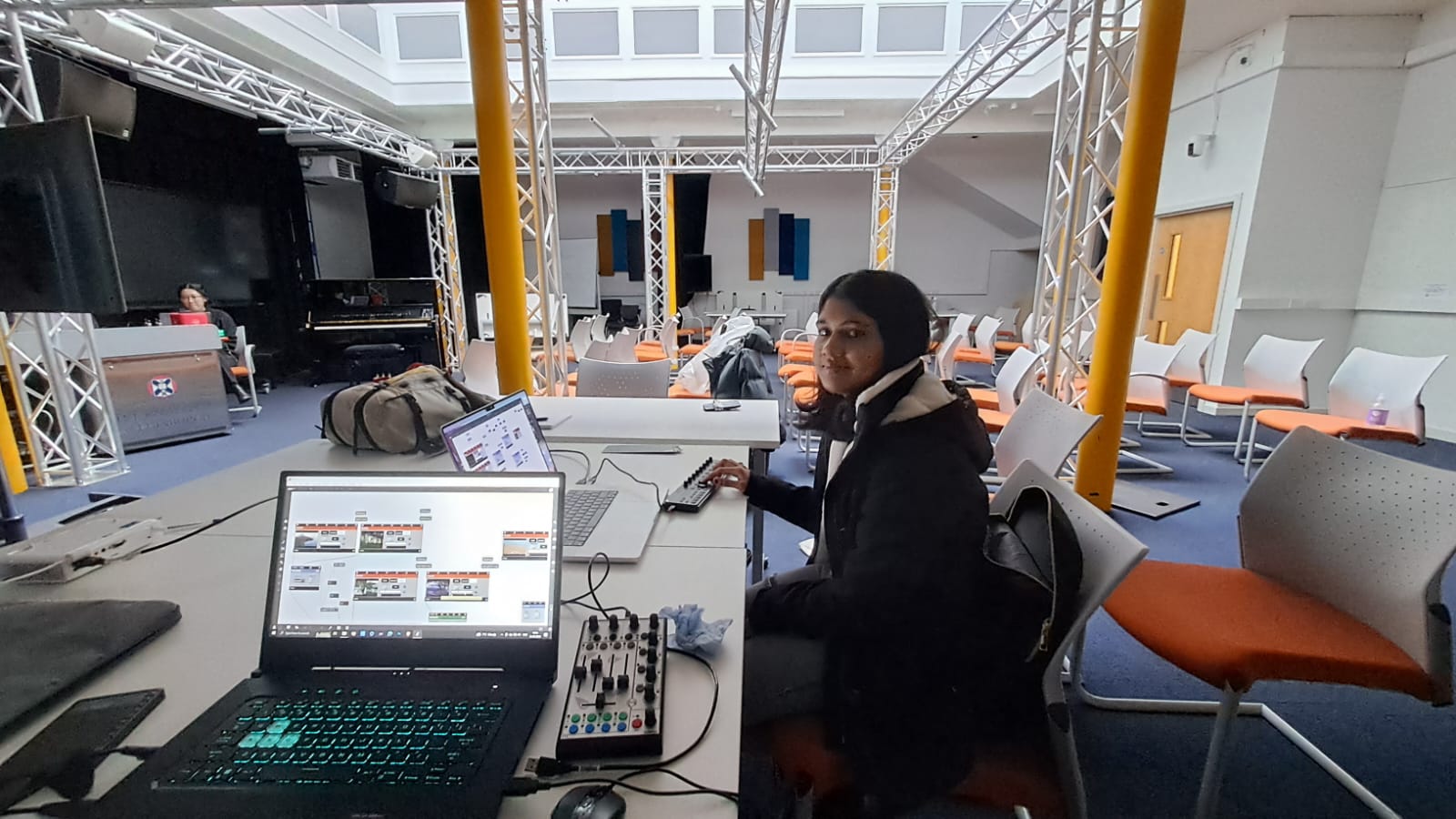
Vibha working on her Vizzie patch

Vibha, Owen and Mengru practicing
22.03.23 Putting together music
Mengru and I (Owen) are writing the music for the performance. It is going to be a combination of sound design and music.
Today (22.03.23), I continued my work on the soundtrack. Using ONLY samples that Mengru and I recorded (hitting/squeezing plastic and metal bottles/cans etc.) and some light processing (resonator, reverb, boosting sub frequencies), I came up with the few bars of music below. I was pleasantly surprised with the result – the sounds from an empty plastic water bottle in particular were very useful in terms of adding texture and movement to the percussion layer.
Perhaps it would be beneficial for each of us to be assigned specific bars of music out of the entire timeline; or perhaps we should write the music for all bars together with each of us taking a specific component of the music (e.g. percussive vs melodic instruments). We will decide soon!
Meeting 13th February
We had a quick meeting with Andrew today to check-in on the progress of our project. The main item discussed was that of the performative aspect of our installation. For example, it is an open question as to whether audience interaction counts as a performative act. If we, for example, let the audience ‘choose their experience’ at the beginning of the corridor, are they then performing the installation? In my opinion, the audience would need to be aware of the decisions they are making in order for it to count as a performance. I believe that is one of the main criteria for performance: a decision is being made live that influences what is being seen and/or heard. To be discussed further….!
Meeting 10th Feb
This post discusses another short meeting we had to discuss the Whats’, Whys’, Wheres’ and Hows’ of our performance.
We decided to focus on what we’ll be presenting first and then let the performance dictate the technology, and go with layers of engagement, as advised by our professor Jules Rawlinson.
Regarding the constituents of our performance, we discussed the possibility of having certain modules that we present to the audience. This could simply mean we show, for instance, eight modules in a linear format. We also had the idea to present the user with questions in a similar formant to Netflix’s Bandersnatch, where the audience’s experience will vary based on the choice they made. This means we create a random set of multiple modules and have them presented in sets of probability. The ideas for the sets are as follows:
1. Presenting characters from Alice in wonderland in a dystopian setting. For example, the dining scene could be set in a an environment of death, decay and pollutants.
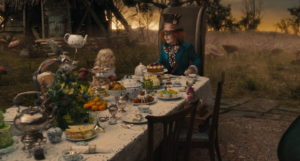
(Img src: https://in.pinterest.com/pin/531776668471571265/)
2. Morph the characters in the corpse bride format
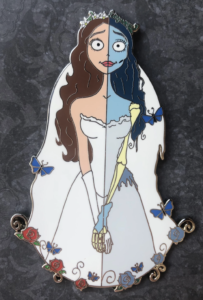
(Img src: https://www.etsy.com/uk/listing/842017487/fantasy-pin-inspired-by-corpse-bride)
3. Cheshire Cat enters and disappears narrating certain events/asking certain questions
4. Show the users harmonising vs disharmonising notes and have them select their path, and have their experience vary based on this choice.
5. The user begins their experience by falling into the rabbit hole. They could end their experience feeling like this was a bad dream they woke up from. i.e, out of the rabbit hole.
Regarding the aesthetic, we decided to go with a fantasy theme rather than showing realistic visuals of global warming. We generated a moodboard with images generated by AI for the 3D modelling style we want to employ. 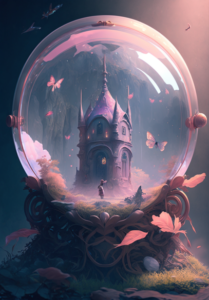
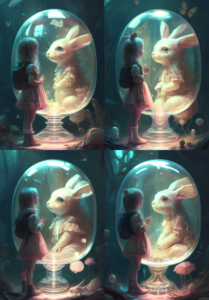
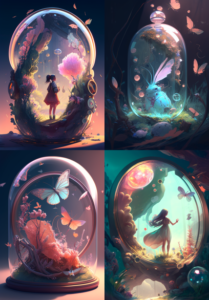


Regarding the location, we are considering west court, with multiple screen barriers dictating the walking path of the audience. We currently don’t know about the number of audiences we will have at one point in time.
Regarding the technology, we had a few ideas:
1. We could use arduino pressure sensors for the Bandersnatch like decision making aspects of the performance. We are also considering USB dance mats for this feature.
2. We could use AR for showing a dystopian version of a certain element on screen. The users scan a code on the projected object and it shows them the decayed version of it.
3. We could midi boards to show the harmonising sounds
4. Multiple speakers and multiple projectors to show the forward progression of the presentation as the user walks forwards.
We will be discussing and building more in the coming days!
Submission 1
General Plan
During our very first meetings as a group, we all became very inspired by Lewis Carroll’s Alice in Wonderland (AIW). Initially, we thought of re-creating a scene from this story in an immersive format. After Mengru joined our group, however, we decided to weld her idea of doing something related to the effects of climate change to our AIW idea.
As it stands now, we are planning on creating an audiovisual installation in which attendees experience the effects of climate change – in particular that of pollution – while still using AIW as an aesthetic and conceptual reference.
Basically, each attendee will enter a corridor, and as they make their way through it, the environment around them will begin to decay.
The beginning of the corridor will immerse the attendees in a tranquil, natural scene, e.g. an open field with the sounds of birds and insects. This will be expressed through projected visuals along the walls and loudspeakers scattered throughout the area. Then, gradually, pollution will infect the scene: visually (through 3d models of pollution superimposed on the visuals) and sonically (through the natural sounds being replaced by sounds of clanking garbage). These visual and sonic modulations will be triggered by the attendees (through Arduino sensors etc.) and performed live by members of our group (through MIDI controllers etc.)
We intend for attendees to leave the exhibition with all feelings of zest and vibrancy having been depleted.
motivations
Climate change is something that affects the entire planet, and since the members of our group span 3 distinct regions of the world (USA, India, and China), this is a topic to which we can all relate.
It is also a topic for which there exists a plethora of scientific data, which we can use to inform our creative choices (and, in the case of data sonification, precisely dictate them).
KEY WORDs
decay; deterioration; pollution; waste; barrenness; desolation; curious; fantastical; psychedelic;
location
Our ideal location would be the West Court room at ECA, because it has plenty of space and can feasibly be blacked out. Within this room, our plan would be to construct a standalone hallway for the attendees to move through.
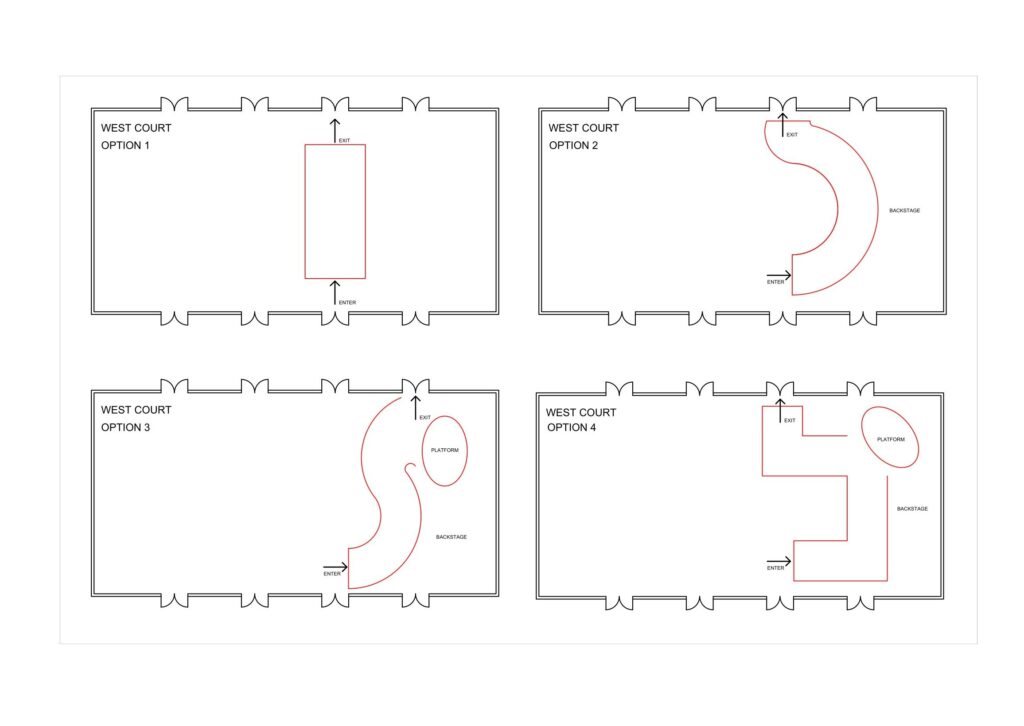
The above image shows a few ways in which the standalone hallway can be positioned. This could change based on what and how we want to display our performance. The main idea was to have the attendees enter through one door and exit through another.
Working Title
“Save me, Destroy me” is inspired by the notes in Alice in Wonderland which are attached to the drinks or cakes. These cakes and drinks are meant to make Alice shrink or grow, while the choices made by human being, or the attendees in this case, would make a difference to the environment as well.
Project Form
During the performance, the attendees would enter an Alice in Wasteland. They would be provided with Yes-or-No questions, and their choice would make a difference to the projected environment. Due to the influence level of their choices, the member of the group would perform differently through sound and visual, while all the difference will layer together instead of vanishing.
Audio
Recording:
Since the pollution could be one of the large problems that threaten the climate changing, the sound designers plan to do some recordings with wastes like plastic, metal, etc. As for the liquid pollution like oil, it is possible to use devices like playtronica to collect the sound as a sample. The recordings would be sent into samplers to produce a full range of notes, or become an effector for guitar or bass through coding or embedded programming.
Composition:
Due to the character of chords, we decided to perform major chords if the attendees make a “good choice”, while minor, inharmonic chords, or even noises for a “bad choice”. Since the question might lead to different kinds of pollution or impacts, the tune of the music will be sampled from the waste we use as mentioned above. As the attendee keeping going on the questions, the former sounds will maintain and the new sound will become another layer to join the whole composition.
Tech:
- ~6 loudspeakers on stands throughout the hallway (Genelecs rented from ECA Music Store)
- Max/MSP for generating and manipulating sound. This software can communicate with Arduino boards if we choose to use them. It also has the advantage of Jitter, which could be used to generate some of the visuals. It would be streamlined to have the sound and visuals being manipulated from the same piece of software.
- Ableton Live for additional sound generation and manipulation.
- MIDI keyboards and/or controllers for live sound manipulation. For example, the Akai MPD 24 that can be rented from the ECA Music Store:
- Analog instruments, e.g. Mengru plays bass, so she could definitely use that (combined with fx pedals) to add to the soundscape.
- If desired, there can be a few points at which attendees can walk up and put on a pair of headphones, if for example we have a localized and specific sonic experience that we wish to impart.
Visual
Environment: We’re asking ourselves what Alice in Wonderland truly is. Lewis Caroll spent years learning the way children’s minds functioned, and the innocence and imaginative freedom they possessed. We hope to create a similar peculiar and imaginative style in our audiovisual projections of pollution.
Tech:
- Arduino pressure sensors/USB dance mats based on availability: We can use this for the decision making parts of our game, where stepping onto the pressure sensor will trigger a question thus altering the audience’s experience.
- Adobe creative cloud and Maya: For creating motion graphics, illustrations and 3D models.
Moodboard:
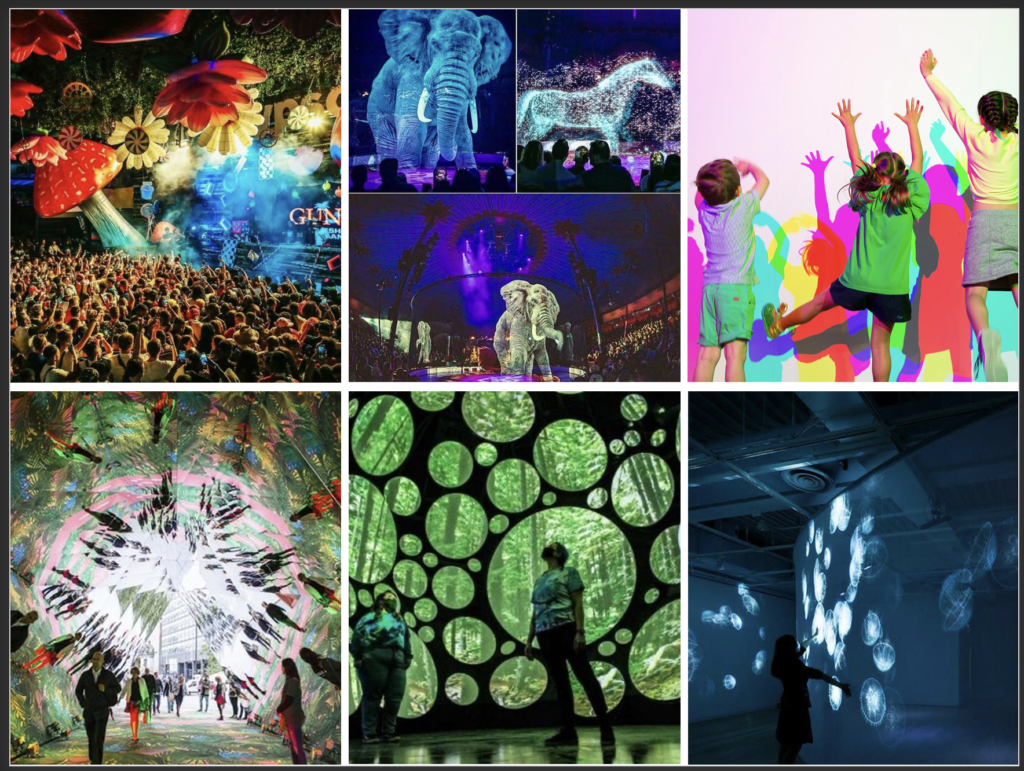
We hope to use the visual style of the flowers and the lighting style similar to these images. The moodboard serves as a visual aid for the nature projections, and a representation of our hallway based projection
Image source 1 | Image source 2 |Image source 3 | Image source 4 | Image source 5 | Image source 6
INSPIRATIONS
- Dismaland | 2015 | Banksy | Weston-super-Mare, England
This was an art installation that expressed various forms of environmental and societal decay. The feeling of dread imparted on attendees is something we are going for as well.

photo source - Sounding Climate | 2019 | National Center for Atmospheric Research | Colorado, USA
This was an exhibit that expressed some of the processes of climate change through sound. It is a solid reference for how to sonify this kind of data.
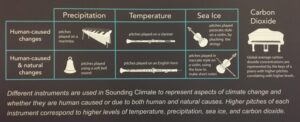
- Light Green Leaves with Light | 2013-2014 | Kyunggi Creation Center, Ansansi, Gyunggido
This exhibit creates a 3D projection using thin screens, using 3 blueray players, 3 6000ansi projectors, and 16 sets of screens. It’s an interesting alternative to holographic projections if we decide to use them for the central part of our performance.
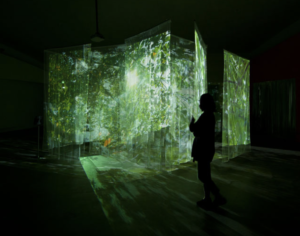
- Ocean Vortices | 2017 | Teamlabs | National gallery of Victoria
This is an interactive exhibit where movement and velocity causes changes in the visuals.
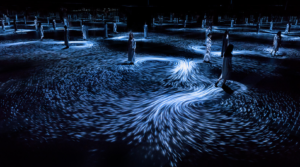
- Immersive Kelaidoscope | 2015 | Kiplings | London Sutton Walk, South Bank
This exhibit is of a kaleidoscope where people become part of the kaleidoscopic visuals being created. We could possibly do the same with a webcam and interlace it with fractals of garbage and garbage beings.
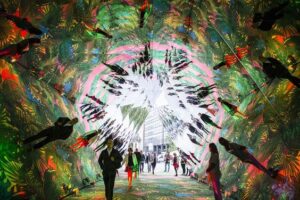
open questions
These are important questions that we are still mulling over as a group.
- What is the message we want to impart on attendees? Is our installation accusatory in the sense that we want attendees to feel blamed for the effects of climate change? Since that topic is not so straightforward, perhaps we should just raise awareness about these issues instead.
- What type of pollution should we target? Options include plastic, metal, greenhouse gases, and more. An obvious consideration here is which type of material lends itself to sonic and/or visual performance. Metal, for example, is generally much more resonant than plastic and therefore would be easier to incorporate into a soundtrack.
- Are we the only performers, are the audience performing, or is it some combination thereof?
- Should we prompt the attendees at the beginning of the corridor with some kind of question that dictates their experience? E.g. how much pollution do they want to see affecting the environment. Are the attendees then ‘performing’ part of the installation?
reference list
Aesthetic References
- Burton, T. (2010).,Alice in Wonderland, Walt Disney Studios Motion Pictures.
- Andrew, Stanton et al., WALL-E. Burbank, Calif., Walt Disney Home Entertainment, 2008.
- VanGoghAlive(2022)., [Exhibition], Festival Square, Edinburgh., 17th Marth 2022 – 17th July 2022., Available at: https://vangoghaliveuk.com/edinburgh/
- Garbage-punk:
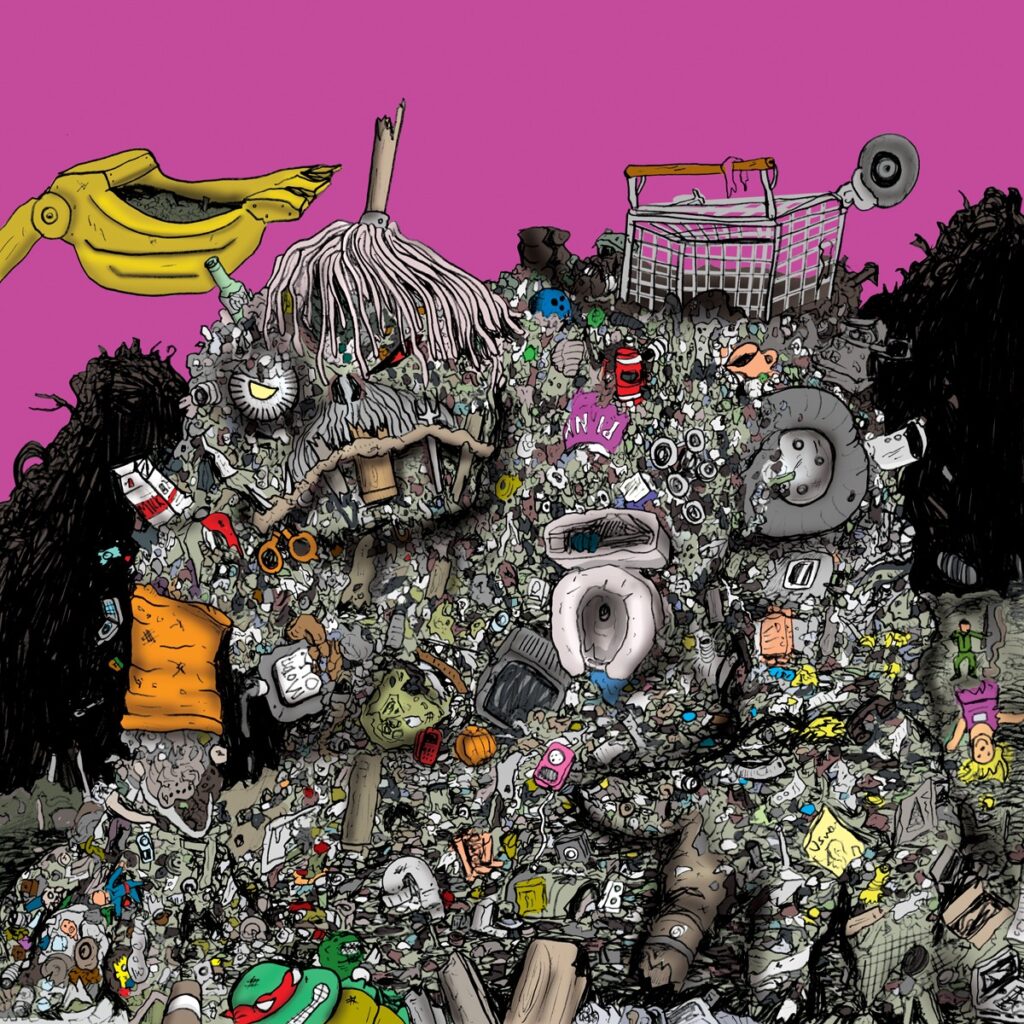
Climate Change References
- DACA
This is an organization that curates works of art built on climate change data. -
Griniuk, M. (2021) ‘Participatory Site-Specific Performance to Discuss Climate Change and Water Pollution’, Pluriversal Design Conference Series [Preprint]. Available at: https://dl.designresearchsociety.org/pluriversaldesign/pivot2021/researchpapers/42.This paper talks about performance art themed around climate change and water pollution.
Academic References
This is a book that explores the possibilities of sonification in the realm of data science.
Meeting 6th February
By now, we have pretty much committed to the idea of an immersive installation displaying the effects of climate change on our environment……..while still using Alice in Wonderland (AIW) as a point of reference for visual and experiential concepts.
We had another meeting with Andrew today, and by this point, here is what we are grappling with:
- using (borrowing) the narrative arc of AIW as a way to establish a trajectory for the attendees’ experiences
- this would be a way to have some kind of firm structure (plot) to reference when shaping the experience of our attendees. An obvious first example could be referencing Alice’s descent down the rabbit hole when constructing the entrance to our installation.
- Anthropocene
- Andrew brought up this concept during our meeting. It refers to the segment of history that began once humans began to have serious effects on the world’s climate. It is a way of distinguishing and making clear our role as humans in climate change. As a group, we want our installation to remind people / demonstrate to them the role they have in climate change, so this is definitely a concept worth looking into.
- decay vs chaos
- this is a distinction I thought of at some point during our discussion. Do we want to demonstrate the environment decaying slowly into a bleak wasteland, or do we want to demonstrate the environment spinning into unlivable chaos? Perhaps we should let science inform the decision here (i.e. find out which scenario is a more accurate prediction).
- deciding on a space (e.g. West Court)
- We should decide on a location for the installation soon, that way we can began making specific plans for the setup.
- what technology will be used?
- Possible technology includes:
- Video
- projectors (mini and/or normal-sized)
- Sound
- Arduino-powered sensors, e.g. pressure, proximity
- loudspeakers (Genelecs rented from ECA)
- Other
- iPad for touchscreen interaction
- MIDI controllers for sound and/or video manipulation
- Video
- Possible technology includes:
- name for project
- “Alice in Wasteland”
- performative aspect
- We need to iron out how the attendees (or us) will perform as part of the installation. Part of this could be accomplished by live manipulation of the video and/or sound.
- sound design reference
- Final scene from Annihilation (2018)
- We could make a soundtrack with the one from this scene as a reference – the sounds are very otherworldly.
- Final scene from Annihilation (2018)
- flower reference
- We think it would be useful to narrow-in on a specific consequence of climate change, e.g. what is going to happen to flowers and plants.
- If we try to represent the effects of climate change more generally, then I believe the experiences of attendees will not be as poignant.
- We think it would be useful to narrow-in on a specific consequence of climate change, e.g. what is going to happen to flowers and plants.
First Steps
Good day and welcome to our blog. Here you will find updates on our progress.
Splitting into groups
After meetings with Jules and Andrew on 2nd February, the entire Performance group decided to split up into two smaller groups of 4 and 5.
Our group includes me (Owen), Shruti, Vibha, Maggie and Yi.
We have a solid mixture of technical backgrounds: 3 students from Design and Digital Media, and 2 students from Sound Design.
We are leaving open the possibility of consolidating the two groups later on, but for now, we will operate separately.
Initial ideas
Shruti, Vibha and I (Owen) met on 31st January for some initial brainstorming. This was a very casual and open-minded brainstorming session—we just shared whatever came to mind. Here is what we came up with:
Theme of homesickness
Since all three of us (and now, indeed, all 5 of us) are foreign students, something we can all relate to on an emotional level is the feeling of being homesick. Since, in my experience, it is easier to work creatively about topics to which one has an emotional connection, I considered this theme to be a great potential starting point.
In terms of what the art might actually look like, we had a few ideas.
1 – Prompt the public to send us photos of a room or section of their home that they particularly miss. We could then project a sequence of these photos onto a wall and, for each photo, play a soundtrack that immerses the viewer into that room (e.g. sounds of cooking for a kitchen photo.)
2 – Using a digital drawing surface (e.g. iPad), prompt attendees to walk up and draw a single material possession from home that they particularly miss. Crude drawings would be welcomed – it’s not only skilled visual artists that could join. These drawings would then be projected onto a wall and form a collage. Perhaps the drawings could then be manipulated/transformed in some way live.
Tribute to Leonardo Da Vinci
Da Vinci’s inventions aren’t as well known as his paintings. The idea was to sonify his paintings which would be moving and projected. These would also include his product designs. Adding an AR element to the experience would be to scan the product and see it in motion outside the painting. An example of one of his product designs is this drawing of a glider:

Alice in Wonderland
Vibha brought up the idea of re-creating one or more scenes from Lewis Carroll’s Alice in Wonderland. This is a story rife with visual depth: hallucinations, transformations, distortions, etc. So we viewed it as a great source of inspiration. The story also has plenty of opportunities for psychedelic sound design and/or music.
Narrowing Things Down
The five of us met on 4th February to continue brainstorming.
By this point, the Alice in Wonderland (AIW) idea was becoming our favorite. However, we agreed that, while it would probably be fruitful to re-create part of the story of AIW in the form of an immersive installation, that has been done before many times ( example ) , so it wouldn’t be very original. Instead, we wanted to decide on a broader theme that we could tackle while using the AIW aesthetic and storyline as a (major) point of reference.
Since Maggie had already wanted to do a project on climate change/environmental collapse, we decided to use that. This is both an urgent and complex topic that all members of the group care about.
We then came up with the idea of Alice in Wasteland – an immersive installation in which the attendees experience a version of what is predicted to happen to our planet over the course of x years due to the effects of climate change. So the attendees would progress from a vibrant and colorful world to one that has decayed into a bleak and desolate wasteland.
I’m going to end by including some of Xu’s ideas.
I’m more inclined to do live installations, not animation, I didn’t express it clearly before. On-site installations will have more visual tension than virtual ones. If we want to do virtual reality, we can do some plant animations that die due to the influence of the environment, in the form of AR.
The following are ideas based on on-site(live) installations, not virtual ones:
1.Thoughts on the Alice theme:

A scene like this can be made to represent the space of Alice’s dream. There is a kind of illusory feeling, which makes people unable to grasp and have no sense of reality. There is a similar expression technique in “Interstellar”, to express a three-dimensional space.
- The end of Alice’s story (expression in the positive version):

 Finally, the sun shines into that scene, helping things to gain new life, and freeing people or animals and plants that have been affected by the environment. The broken glass, which could be a rabbit or something else, breaks free from that environment, and there is a visual tension of a two-dimensional breakthrough to three-dimensional. The part of Sunshine brings passive relief, Things cannot escape the influence of the environment, they can only wait to be changed. The part of breaking, this expression is to actively change (but in fact, those things have not changed the original environment, and jumped to another dimension for relief)
Finally, the sun shines into that scene, helping things to gain new life, and freeing people or animals and plants that have been affected by the environment. The broken glass, which could be a rabbit or something else, breaks free from that environment, and there is a visual tension of a two-dimensional breakthrough to three-dimensional. The part of Sunshine brings passive relief, Things cannot escape the influence of the environment, they can only wait to be changed. The part of breaking, this expression is to actively change (but in fact, those things have not changed the original environment, and jumped to another dimension for relief)
- Thoughts about being influenced by the environment:

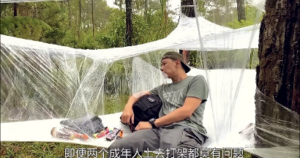 We can use some plastic wrap and cloth to wrap things in the main environment to express the emotions, suffocation, and struggle that may be caused by the influence of the environment.
We can use some plastic wrap and cloth to wrap things in the main environment to express the emotions, suffocation, and struggle that may be caused by the influence of the environment.